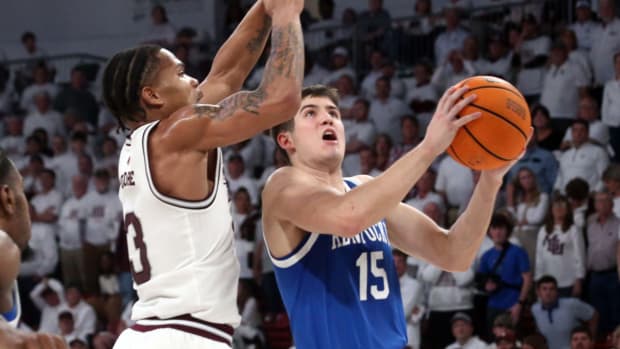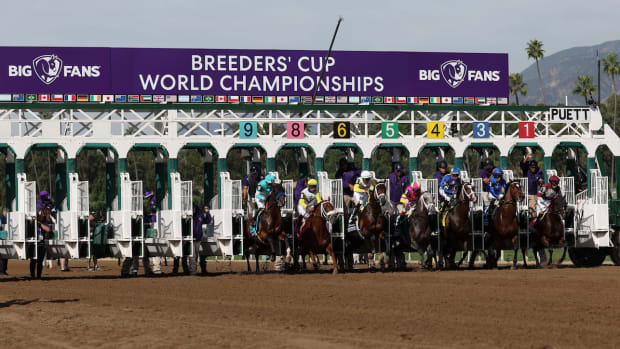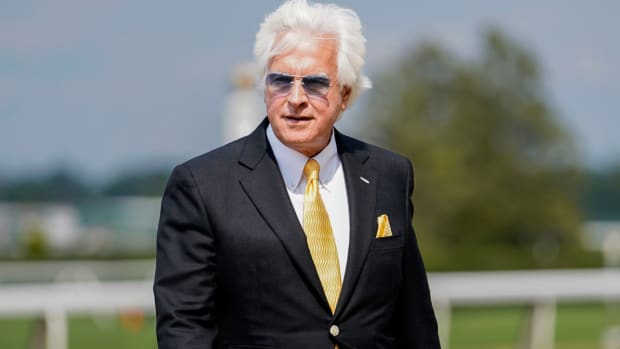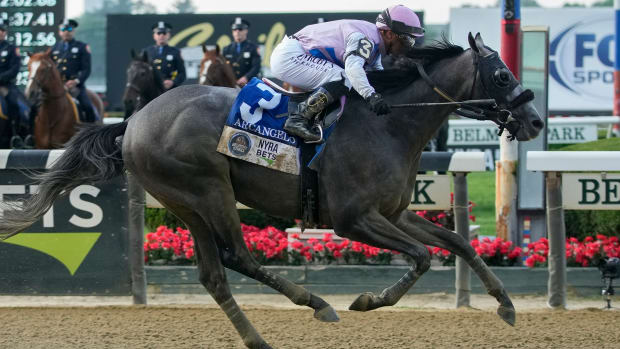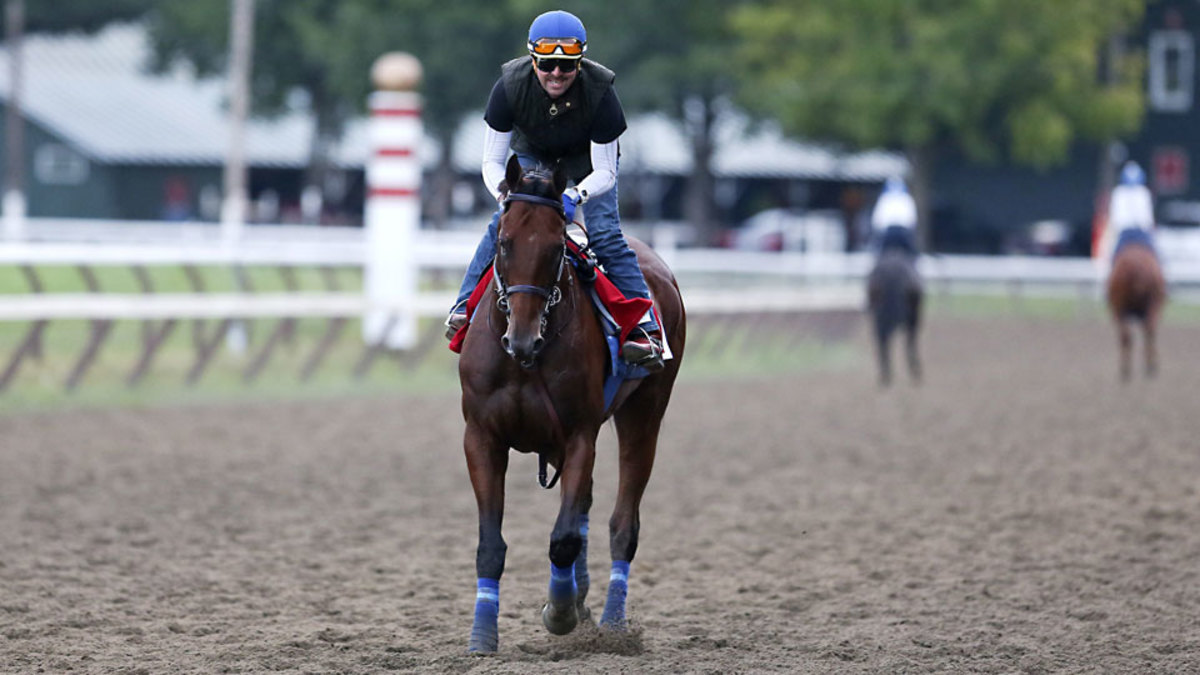
American Pharoah's run in the Travers sure to have fans holding their breath
There is no place in American horse racing quite like Saratoga, a racetrack in the small city of Saratoga Springs in upstate New York, at the point where that state finishes its long, northbound transition from steel grey to nature’s green and launches into six million acres of Adirondack splendor. It was the great Red Smith who supposedly once wrote of Saratoga, “You drive north for about 175 miles, turn left on Union Avenue and go back 100 years.”
Strictly speaking, this is no longer fully accurate, unless a century ago there was a Shake Shack adjacent to the racetrack’s paddock or an endless canyon of high-priced condominiums just west of Broadway. Many of the old Victorian homes within a short walk of the track have been retrofitted with the very finest in everything. Only their façades evoke another time. Saratoga is keeping up just fine.
But Red wasn’t wrong then and his sentiment isn’t wrong now. Saratoga is one of those rare places where a bygone sport is still treated as if it’s 1937. Where earnest, adoring crowds pass through the track’s shaded gates, six days a week, for six weeks from late July until Labor Day, and worships racing like the rest of America worships the NFL. Where racing is not just a diversion, but a passion. There are other places like this: Del Mar in the summer, Churchill Downs during Derby week, Keeneland during its boutique weeks, a few days at Oaklawn Park. All have their merits; none will save the sprawling enterprise of thoroughbred racing or return it fully to mainstream relevance.
And none is quite like Saratoga. So it is appropriate that on Saturday afternoon American Pharoah, the most significant American racehorse in nearly four decades, will run in the Travers, the centerpiece of the Saratoga meet and historically—if not always practically—one of the most respected races in the country for three-year-olds. “The prestige of Saratoga,” says Pharoah’s owner, Ahmed Zayat. “That’s why we’re coming. I want to add to American Pharoah’s legacy.”
Saratoga is Wimbledon. Saratoga is Augusta. Saratoga is Fenway, Wrigley, Yankee Stadium. So yes, of course. It is perfect that the sport’s first Triple Crown winner in 37 years will run here. (And perfect that a crowd estimated at 15,000 turned out on Friday morning to watch Pharoah gallop once around the track.) Perfect, but not simple. With a half ton of horse as valuable—and beloved—as American Pharoah, it won’t be simple until he’s finished running.
(Let me get a disclaimer out of the way: I was raised 50 miles north of Saratoga; the first major sporting I covered—and badly, I might add—as a professional journalist was the infamous 1978 Travers rematch between Triple Crown winner Affirmed and his, nemesis, Alydar, a race that ended with Affirmed passing first beneath the wire and then being justly disqualified. Between that summer of ’78 the end of August of ’88, when I left that area for a job in New York, I spent thousands of hours in the rickety Saratoga press box where I will be sitting on Saturday. So I’m not entirely dispassionate about the place, though I like all those other tracks, too.).
Shortly after Pharoah’s historic victory in the Belmont Stakes on June 6, Zayat promised that his colt would continue to race through the rest of the year, as long as he remained healthy and vibrant. This decision was largely welcomed by the racing community, which had so often bemoaned the early retirement of superstar horses because of their value as stallions (multiples higher than as racehorses). There was also a vocal minority that couldn’t—and still can’t—believe that Zayat and trainer Bob Baffert are risking Pharoah’s health (and their collective investment, as well as that of Coolmore, the Irish-based breeding outfit that paid for Pharoah’s breeding rights last winter) by continuing to race him. It has been, and remains, an intensely complex discussion.
American Pharoah dominates Haskell in return to racing, answers doubters
Pharoah’s first race back was on Aug. 2 in the Haskell Invitational at Monmouth Race Track, hard by the Atlantic shoreline in Oceanport, N.J. Never mind that Monmouth officials scared off thousands of potential spectators with dire traffic warnings and then issued an attendance figure (60,983) that seemed exaggerated (unless there were 15,000 fans in hiding somewhere on the grounds). The day was electric. Fans clambered around Baffert and Zayat as if they were kings and cheered Pharoah in full throat as he galloped away to an easy victory. These are the people who did not see Secretariat or Seattle Slew or Affirmed. Pharoah is their superhorse. It was all very real. It is a long encore, yet with no promises.
Still: When Pharoah runs, there are dueling emotions. Number one: Be American Pharoah. Run like you run. Win. Give me my Pharoah moment. Number two: Get around there safely. These same feelings are in play during any horse race, but Pharoah is not just a fast horse anymore, he is public property, little pieces of his greatness given to fans everywhere. And as Zayat says, echoing what everybody in the game knows, “Horses aren’t made like they were in the old days, when they ran so many races.” So when Pharoah runs, people hold their breath.
Then there is the money. The American Pharoah story is a beautiful thing, man, but this is a professional sport played and controlled by people with fat wallets and a desire to make them fatter. When Zayat announced that he would continue racing Pharoah, there were whispers in the game that he was trying to milk more money out of his horse because he had sold his breeding rights early. According to two sources, Zayat sold the breeding rights to Pharoah in January, when he was a two-year-old champion but had not run a race as a three-year-old. That contract, Zayat says, allowed him to keep control of the horse through 2015 and included numerous kickers for winning races. Obviously, Pharoah has fulfilled many of those kickers. Whether he has fulfilled enough to counterbalance selling the breeding rights to a Triple Crown winner in January is unknown.
Zayat said to me in July, and repeated this week: “No money was left on the table.” He also said, “People seem to think I need money. When I filed for Chapter 11 [in 2009], that was Zayat Stables, not Ahmed Zayat. I have been a wealthy and successful man and I will remain so.”
To emphasize his point, Zayat at first said, this week, that Coolmore had offered to “buy out” his contract after the Haskell by paying off all the remaining kickers and retiring Pharoah. Then he amended that to say, “It was just a discussion (not an offer). It didn’t go anywhere because I have zero interest in retiring him now. The Irish are great guys for letting me do what I want with Pharoah.”
Coolmore, as a matter of practice, does not publicly discuss its business in the media and doesn’t take ownership of Pharoah until 2016. It is clear that the company’s purchase in January was an exceptionally good—and lucky—deal. They were buying a two-year-old champion with good breeding; nobody knew he would become transcendent. In truth, it was a good deal for Zayat, too, because he also had no idea what would happen in ensuing months. People in horse racing go broke waiting for greatness to happen.
Zayat gets enthusiastic when talking about Pharoah and when talking about money. He has claimed passionately since the Belmont that he is racing Pharoah in order to share the horse with the public and because “our sport needs stars.” Whatever his motivation, he is doing exactly that, when many others have not, and would not. People seeing Pharoah now will remember the experience for a lifetime.
Yet the more precise decision on whether to keep moving forward with Pharoah has been left to Baffert, a 62-year-old Hall of Fame trainer who has seen most of what there is to see in racing, yet has seen nothing like American Pharoah. When I visited Baffert in California in July, he was steadfastly uncertain if he would race Pharoah again. Ever. “If he shows any signs of going backward,” said Baffert then, “we’ll retire him on the spot.”
But the horse refuses to go backward. His Haskell, according to jockey Victor Espinoza, was the best race of his career. His two works since then have been stellar. After the first of those works, on Sunday, Aug, 16, I texted Baffert:
Me: “Horse never gets tired.”
Baffert: “Never. Doesn’t have an ounce of fat on him. Total stud.”
Initially, Baffert wasn’t crazy about coming to Saratoga. He’s one-for-five in the Travers and feels like the track can play a little funky, leading to upsets. Zayat wanted to come all along, and Pharoah decided the issue with his training. He flew to Saratoga overnight Wednesday and has settled in as if he’s still home.
American Pharoah gets 1st look at Saratoga Race Course
Baffert’s Saratoga phobia plays into the track’s historic reputation as the “Graveyard of Favorites.” (That is a haunting term, in this context). In truth, that nickname was earned on the wings of three races: Upset’s victory over Man o’ War in 1919, Jim Dandy’s win at 100-1 odds over Triple Crown winner Gallant Fox in 1930, and Onion’s victory over Secretariat—which Baffert still remembers—in the 1973 Whitney. Those races were a long time ago. A lot of great horses have come to the Travers and won, including Baffert’s great Point Given in 2001.
Pharoah will face solid opposition, most notably Texas Red, who won the Breeders’ Cup juvenile (after American Pharoah was injured), missed the Triple Crown season with an injury of his own and on Aug. 1 impressively won the Jim Dandy at Saratoga. Like several other horses in the race, Texas Red has been training at Saratoga, which is often considered an advantage. In this regard, American Pharoah is racing half the field on its home court/field/rink. It’s a genuine test at the Kentucky Derby distance of 1-¼ miles.
And now, in the late days of summer, another opponent looms on the horizon. Last Saturday in the Pacific Classic at Del Mar, Beholder, a five-year-old mare, defeated a field of males in stunning fashion. It’s possible that American Pharoah will find her waiting in the Breeders’ Cup Classic on Oct. 31 at Keeneland in Kentucky. It would be a matchup for the ages and a final challenge for the horse of a generation.
That will wait. For American Pharoah and his team, there is one race and one race only and then the process beings anew. There is a Saturday at Saratoga. A breath held deeply and one lap around the track.

